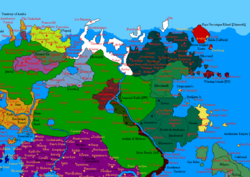East Keltian Collapse: Difference between revisions
mNo edit summary |
|||
| Line 78: | Line 78: | ||
The Anahuacan refugee situation proved more complex, with between 4-7 million people fleeing the collapsing empire. As the largest [[Martino language|Martino]]-speaking nation in [[Micras]], [[Nouvelle Alexandrie]] faced significant pressure to accept Anahuacan refugees despite not sharing a direct border. The [[Federal Assembly of Nouvelle Alexandrie|Federal Assembly]] established a special commission to manage the anticipated influx, though the geographical distance meant many refugees would need to traverse multiple borders to reach New Alexandrian territory. | The Anahuacan refugee situation proved more complex, with between 4-7 million people fleeing the collapsing empire. As the largest [[Martino language|Martino]]-speaking nation in [[Micras]], [[Nouvelle Alexandrie]] faced significant pressure to accept Anahuacan refugees despite not sharing a direct border. The [[Federal Assembly of Nouvelle Alexandrie|Federal Assembly]] established a special commission to manage the anticipated influx, though the geographical distance meant many refugees would need to traverse multiple borders to reach New Alexandrian territory. | ||
[[Moorland]], sharing a direct border with [[Anahuaco]], became a primary destination for fleeing Anahuacans. The Moorlandic government established seven official border checkpoints while maintaining strict control over the rest of the frontier. Under the direction of King [[Alpin MacMartin]], Moorland implemented an expedited citizenship program specifically for Anahuacan refugees entering through legal channels, aiming to facilitate their integration into Moorlandic society. | [[Moorland]], sharing a direct border with [[Anahuaco]], became a primary destination for fleeing Anahuacans. The Moorlandic government established seven official border checkpoints while maintaining strict control over the rest of the frontier. Under the direction of King [[Alpin MacMartin]], Moorland implemented an expedited citizenship program specifically for Anahuacan refugees entering through legal channels, aiming to facilitate their integration into Moorlandic society. [[Burwood]], already facing a gigantic influx of Norse from [[Normark]], could only accept a small amount of Anahuacans for re-settlement. [[Huntsland]], which has the largest amount of Anahuacan people, was able to accept around 50,000 refugees; although this stretched the resources of the region. Most of the remaining refugees are being directed to the ports of [[Newhaven]], where ships have been chartered to bring them to hospitable destinations such as [[Nouvelle Alexandrie]]. | ||
==Aftermath== | ==Aftermath== | ||
Revision as of 14:39, 31 October 2024

|
This article or section is a work in progress. The information below may be incomplete, outdated, or subject to change. |
| East Keltian Collapse | |||||
|---|---|---|---|---|---|
| Part of Streïur uis Faïren, Wars of the Dispossessed | |||||
  Top: Republicanos advancing into Ciudad de Anahuaco; Bottom: Map of northeastern Keltia prior to the collapse, 1736 AN. |
|||||
|
|||||
| Belligerents | |||||
| |||||
The East Keltian Collapse refers to a series of political and military upheavals that occurred in northeastern Keltia during 1737 AN and its aftermath, resulting in the fall of several Raspur Pact-aligned nations. The collapse primarily affected Normark and Anahuaco, while also destabilizing neighboring Cerulea. This event marked a significant shift in the balance of power on the continent, weakening the Raspur Pact's influence and allowing for the resurgence of the Confederacy of the Dispossessed. The suspicion of Shirerithian support for the campaign which knocked out two regional allies of the Benacian Union was a notable feature of contemporary discourses regarding the rapid upheaval in the north eastern corner of the continent.
The collapse was precipitated by a combination of factors, including internal instability, the ongoing Benacian War, and the gradual fracturing of the Raspur Pact alliance system. The Second Cerulean Revolution in early 1737 AN led to Cerulea's disintegration into The Green, creating a power vacuum that emboldened opposition forces. Taking advantage of this chaos, the reinvigorated Confederacy of the Dispossessed launched successful offensives against Normark and Anahuaco, ultimately leading to the collapse of both nations' governments. Further contributing to Anahuaco's demise was the spillover from the Andilar Wars along Anahuaco's eastern frontier.
As the situation deteriorated, several Raspur Pact allies initiated emergency operations to secure strategic assets and personnel. Notable among these was Operation Northern Light, a joint effort by Nouvelle Alexandrie, Constancia, the Benacian Union, Natopia, and Oportia to extract key scientists, engineers, and officials from the falling nations. Simultaneously, Hurmu conducted Operation Dariolin to evacuate loyalists and secure important cultural artifacts from Normark.
The collapse triggered a massive refugee crisis, with millions fleeing the affected areas. Neighboring countries, including Nouvelle Alexandrie, Aerla, and Moorland, struggled to manage the influx of displaced persons and initiated resettlement programs. The Benacian Union would subsequently take the lead in resettling a significant minority of politically reliable Normarkers in the Governorate of Absentien. The economic aftershocks of the collapse contributed to the Recession of 1737, which impacted many Raspur Pact nations and further weakened the alliance's cohesion.
The East Keltian Collapse represents a pivotal moment in recent Micran history, reshaping regional dynamics and calling into question the long-term viability of the Raspur Pact as a dominant geopolitical force. The Confederacy of the Dispossessed, having enjoyed such stunning success, has deemed the moment "The Great Resurgence" in its propaganda.
The second Cerulean revolution
Normark reels from the blow
Anahuaco buckles
The Fall of Anahuaco details the events immediately leading to the collapse of the Anahuaco Empire. It relies heavily on Raspur Pact sources.
The Eastern frontier of Anahuaco saw significant spillover from the Andilar Wars, where the tribes and kingdoms uniting under the banner of the King of Beorg-Dur organised into the Black Host. Intervening forces from Celebarad attempted to restore peace on the Andilari peninsula, but were unable to prevent the destruction of various border towns of Vicario.
Along Anahuaco's northern border with Moorland, the MAF was deployed to help secure border crossings and deal with the emerging refugee crisis spilling over into Huntsland. As a partner within the Raspur Pact, marines from the MAF coordinated with allied command to perform an extraction of high-ranking assets from Ciudad de Anahuaco. Beyond this, Moorland recognized the humanitarian crisis unfolding at its feet and began a coordinated effort to allow refugees to enter the country. King MacMartin noted that only refugees entering legally through official checkpoints would be allowed a path to citizenship. As of late 1737, seven checkpoints had been established while the rest of the border was closed and patrolled by armed guards. Anyone caught trying to enter the country illegally is either turned away or directed to a checkpoint. Moorland's government has created a special citizenship program just for Anahuaco's refugees allowing that expedites the process of citizenship and assimilation into Moorlander society.
Allied interventions: too little, too late
Rebel forces advance on all fronts
Evacuations
Refugee Crisis
The collapse of Normark and Anahuaco triggered one of the largest refugee crises in recent history, with estimates suggesting that tens of millions of people were displaced. The crisis particularly strained the resources and infrastructure of neighboring nations in Keltia, while also testing the cohesion of the already-weakened Raspur Pact alliance system in managing the humanitarian emergency. The refugee crisis had significant economic implications, contributing to the Recession of 1737 as host nations struggled to absorb the costs of refugee support and integration programs. The crisis also led to demographic shifts in receiving regions, particularly in Absentien and northern Moorland, where refugee communities began establishing new cultural enclaves.
Norse Exodus
The fall of Normark led to a massive exodus of its Norse population. The Benacian Union took the lead in coordinating the evacuation and resettlement of Norse refugees, with the majority being relocated to the Governorate of Absentien. This organized resettlement program focused particularly on those deemed politically reliable, especially those with ties to the Humanist movement. Additionally, Nouvelle Alexandrie accepted approximately 115,000 Norse refugees, primarily settling them in the North Lyrican region due to its cultural similarities with their homeland.
Moorland, being one of the closest neighbors of Normark geographically and a longtime ally, also opened its doors to Norse refugees. Emergency response teams were deployed to the Kells to construct a humanitarian relief center consisting of temporary shelters and medical facilities. The MAF was deployed to construct a military road from Nevermoor west through the Green to Inverkell. While not passable via normal civilian transportation, the road allows military transports access to the Strait of Haifa via a land route. Military transportation will be utilized to transport refugees hoping to resettle in Moorland back east. Makeshift portage is also being constructed at the harbor to allow ships to dock and load refugees for a longer journey north around Mercury. These seafaring vessels will likely offload refugees at other countries that are currently offering aid. Nearly a million Norse refugees are expected to enter Moorland, most of which have cited interest in settling in Burwood, which still has a sizable Norse population carried over from Ostland.
Aerla was also heavily impacted by the collapse of Normark. Most refugees were sent to camps in the Transcaledonian Territory for temporary accommodation before they would be allowed to settle in Aerlan cities. Several border crossings were converted into processing centers were background checks could be conducted and were doctors could vet refugees for illnesses. The largest camp was the one located roughly 10 km outside of the town of Yandarlo, which housed upwards of 15,000 refugees mostly from the western regions of Normark. Port Aerla was also opened to Norse vessels seeking shelter from pirate attacks, with Naval Security Forces being placed in high alert in the Bay of Makonnia.
Anahuacan Diaspora
The Anahuacan refugee situation proved more complex, with between 4-7 million people fleeing the collapsing empire. As the largest Martino-speaking nation in Micras, Nouvelle Alexandrie faced significant pressure to accept Anahuacan refugees despite not sharing a direct border. The Federal Assembly established a special commission to manage the anticipated influx, though the geographical distance meant many refugees would need to traverse multiple borders to reach New Alexandrian territory.
Moorland, sharing a direct border with Anahuaco, became a primary destination for fleeing Anahuacans. The Moorlandic government established seven official border checkpoints while maintaining strict control over the rest of the frontier. Under the direction of King Alpin MacMartin, Moorland implemented an expedited citizenship program specifically for Anahuacan refugees entering through legal channels, aiming to facilitate their integration into Moorlandic society. Burwood, already facing a gigantic influx of Norse from Normark, could only accept a small amount of Anahuacans for re-settlement. Huntsland, which has the largest amount of Anahuacan people, was able to accept around 50,000 refugees; although this stretched the resources of the region. Most of the remaining refugees are being directed to the ports of Newhaven, where ships have been chartered to bring them to hospitable destinations such as Nouvelle Alexandrie.